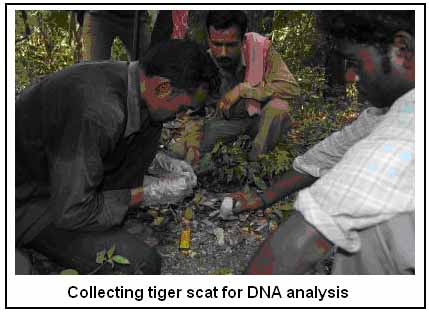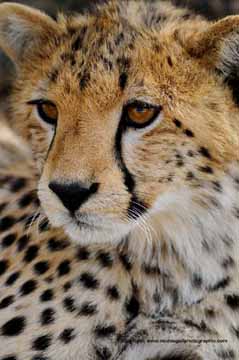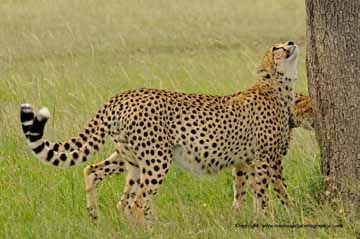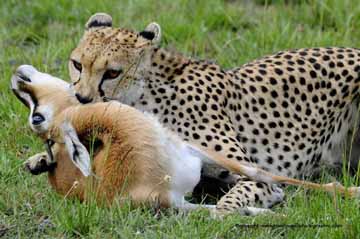Did You Know ?
Water, the next real estate
There is a water crisis up ahead even without help from global warming, says S.Ananthanarayanan.
Two thirds of the earth’s surface is covered by water, perhaps the most abundant resource there is and there should normally be no fear of its running out. The trouble is that all the water is not of the kind we can use, most is salt, sea water. Only 3.5 percent
of all the water is fresh and potable, and again, most of it is locked in the polar ice caps as ice!
Only 0.01 per cent, or one part in 10,000, is in a form which people can use, in streams, rivers, lakes and groundwater aquifers. And then, well over half of this is out of reach, or lost as floodwater.
The spectre of global warming threatens to destroy the ice-locked store by melting glaciers and sending the water into the sea, even if it is through destructive floods in ice-fed rivers. Rising temperatures apart, some may argue that this does not directly
affect water supplies as no accessible water is lost. But this is not true. Not only will the glacier-fed rivers soon dry up, the great threat is that the source for aquifers and ground-water would disappear.
Groundwater crisis
Increased demands for industry and rising populations has been fast depleting groundwater sources. For all the water there may be at the surface, there is a limit to how fast underground storage can be replenished. Aquifers that filled over thousands of years
are being drained in decades. The effects are both local as well as extended, with ground-water level dropping in general, the world over.
A major source of water for communities is from wells and lakes fed from groundwater sources. Rivers, of course, served for transport not only of people and merchandise but also of water and the large human settlements arose on river banks. But there are important
centres of vital resources, and hence habitation, away from rivers too, and this is thanks to ground-water, which gets there through an invisible yet efficient underground channel system.
It is this, underground source, whose depletion, as yet only because of over-exploitation, that would soon gain urgency and grab national and international attention.
Need for managing
Ground-water, being out of sight, is usually taken for granted and it is only of late that communities are waking up to its running out. There have been major disputes over river water flows and levels of lakes and reservoirs. There has also been the development
of a legal framework, national and international, to regulate the use of such surface water.

Picture courtesy the website of Selwyn Johnston, Community Rep. in Queensland, Australia
http://www.johnston-independent.com/groundwater_recharge.html
But in respect of groundwater, there has been neither perceived need for nor possibility of legislation. The legal principle has been resolutely that of ‘ownership of land and everything that grows upon it and can be found within the land.’ The English common
law concept of ‘rule of capture’, which determines ownership of common resources, such as wild game, as belonging to the one who first ‘captures’, has been applied to oil and water resources. This is irrespective of whether it drains out the resource from
the land of a neighbour – because she is considered to own the resource under her land only if she pumps it out! There is no clear rule to deal with an industry that pumps out ground-water and starves a farming neighbourhood and statute to control ecological
damage caused by certain kinds of industry is being slowly erected.
But it is clear that there is great need for administrative and legal attention to this area which is soon to become the world’s first battlefield.
Lessons from oil
Researchers at Oregon State University have recently presented a paper dealing with the problem at a conference in Tokyo, Japan. "In the northern half of Oregon from Pendleton to the Willamette Valley, an aquifer that took 20,000 years to fill is going down
fast," says Todd Jarvis, Associate Director of the Institute for Water and Watersheds at at OSU. "Some places near Hermiston have seen water levels drop as much as 500 feet in the past 50-60 years, one of the largest and fastest declines in the world.” “ In
the process,” Jarvis says, “underground aquifers can be irrevocably damaged – not unlike what happened to oil reservoirs when that industry pumped them too rapidly. Tiny fractures in rock that can store water sometimes collapse when it's rapidly withdrawn,
and then even if the aquifer had water to recharge it, there's no place for it to go.”
The OSU paper takes stock of the problem, worldwide and suggests that the legal framework that has been developed by the oil industry, the hard way, to manage oil exploration, could provide a starting point to control the use of water.
Unitization
A key concept that Jarvis presented at the conference was the idea of “unitization”, which is built around people unifying their rights and their goals, and working cooperatively to make a resource last as long as possible and not damaging it. “Regardless
of what else takes place,” Jarvis says, “groundwater users must embrace one concept the oil industry learned years ago – the "race to the pump" serves no one's best interest, whether the concern is depleted resources, rising costs of pumping or damaged aquifers.”
As with any resource that is scarce, it becomes important to reserve its use for where it has the best economic value. Doing this with water would call for a whole new way of looking at things, and property and civil rights, and a level of cooperation whose
absence has been the hallmark of water disputes, local and international, through the ages.
Agriculture, which is at present the greatest consumer, would still be the priority area, but the methods used will have to change in many ways and traditional agriculture is notoriously wasteful. The arenas of agriculture would also shift to places which can
control access and there would be a new industry of the ‘secondary’ water usage. With river resources shrinking or disappearing, regions where groundwater accumulates would be come the new oilfields.
[the writer can be contacted at Simplescience@gmail.com]
|
Did You Know ?
DNA tracks tigers in the wild
Genetics and the tiger trail
Genetics is now helping save endangered species, says S.Ananthanarayanan.
Genetics has entered all areas of modern life – bio-engineered food is commonplace, livestock breeding has become more aggressive with genetic intervention, medical science is revolutionized and then in forensic science, DNA fingerprinting, for identification
and crime detection, is a daily occurrence.
The Wildlife Conservation Society, New York, has just reported a study published in the journal Biological Conservation, which describes a role that genetic methods can play in helping conserve the endangered Indian tiger. Samrat Mondol, K. Ullas Karanth, N.
Samba Kumar, Arjun M. Gopalaswamy, Anish Andheria and Uma Ramakrishnan, all working in the National Centre for Biological Science or the Wildlife Conservation Society and Centre for Wildlife Studies, both in Bangalore, have developed a DNA based tiger identification
technique which enables sensitive and error free tracking of tiger populations, to monitor and tailor conservation strategies.
DNA fingerprint
If fingerprints are unique to identify a person, her genetic makeup, as recorded in the million-fold variables of DNA is surely unique over millennia. DNA is a microscopic but
giant, thread-like molecule found in the nucleus of cells and whose structure determines how the cell will behave. The DNA thread is a long sequence of units, each of which is a template for the production of one of 20 amino acids, the building blocks of
proteins. Sequences of such units specify separate proteins, which then act as communication between cells, the activity of one group of cells setting off the activity of another group, and so on. As there are millions of activities to be monitored in a living
thing, the DNA is naturally millions of units long.
The remarkable thing about DNA is that it also has an efficient way to clone or create an image of itself – which happens when a cell has to divide. The DNA first splits into two complementary halves and the cell separates, with one half of the DNA in each
part. The half DNA rapidly completes itself from the material of the divided cell and each half becomes a complete cell. In the case of sexual reproduction, as happens with animals, special male and female cells, each with only a half DNA, combine to form
the new individual, with a mix of the DNA components of both parents.
It is in this process of the combination of millions of units of DNA of the parents that some variations must occur, and statistically, it is impossible that any two persons have the same final genetic make-up. In broad areas, of course the DNA would be similar,
which accounts for racial and family resemblance, but in the details, there are always differences, even in identical twins.
Laboratory methods are now available to identify and map parameters of DNA, rather like a fingerprint expert records the slant and width of whorls and loops in a human fingerprint, to enable comparison. DNA can hence be analysed, often entirely by automation,
and compared, using computers, to say in a short time whether a pair of DNA differ or are similar. The ability has become important in crime detection, specifically in saying whether a given person has left her own DNA traces at the site of a crime, or even
in demographic research, like tracing the wanderings of the Roman army by polling for Latin DNA features in European populations.
Counting tigers
Keeping count is an important part of managing anything. Science and engineering are centred around exact measurements and economists and governments depend on
statistics – of resources, producers, consumers. Idealistic schemes to withdraw customs and excise departments result in loss of more than tax revenue – they block the data about movement and production that these departments collect!
But while collecting data of human activity is routinely implemented, collecting data about wildlife is challenging. To know the population of fish in the sea, to get data about migratory birds, we need to use methods of sampling and statistical analysis. One
method of estimating the numbers of fish, for instance is to mark a fixed number of fish and to send them back, to mingle with unmarked fish. When a sample is later snared, the number of marked fish that appear would give and idea of how many fish there are
in all.
While dyes and chemicals have been ways of marking fish, in the case of estimating how many protected whales had been killed, DNA fingerprinting of individual whales, and later watching for their meat to show up in the market was used. With fish and whales,
and even with birds, which can be captured, such methods are feasible. But in the case of tiger populations, which the Wildlife Conservation Society has been monitoring these last 15 years in India, it is not practical to trap and stain tigers or most other
usual population estimating methods.
Using poop
DNA fingerprinting was used, it is true, by firing sedating darts at tigers and collecting blood or tissue samples, but the method was cumbersome and hence not effective. The Bangalore scientists have now developed a technique of
getting the DNA data from tiger droppings. This method is not only ‘non-invasive’ but is eminently practical and amenable to large scale application by personnel with very simple training.
Once tiger DNA are catalogued, it is at least as effective as those tigers being ‘marked’ and their movement or their presence, among others not so ‘marked’, can be tracked by regularly collecting samples of tiger dropping everywhere in the forest.
The ‘gold standard’ for estimating tiger populations is the ‘camera trapping’, where individual tigers are photographed and identified by their unique stripe patterns. This is the rough equivalent of actual fingerprinting, but is clearly impractical where the
tiger densities are low or the terrain is rugged. The study of estimation by droppings was conducted with collecting 58 samples in the Bandipur forest in Karnataka, and was validated against actual camera trapping estimation. Camera trapping is possible in
Bandipur as the populations are in good numbers. The result of the study was that estimations from the DNA data found in droppings was accurate and reliable.
"We see genetic sampling as a valuable additional tool for estimating tiger abundance in places like the Russian Far East, Sunderban mangrove swamps and dense rainforests of Southeast Asia where camera trapping might be impractical due to various environmental
and logistical constraints," said noted tiger scientist Dr. Ullas Karanth of the Wildlife Conservation Society.
"This study is a breakthrough in the science of counting tiger numbers, which is a key yardstick for measuring conservation success," he adds. "The technique will allow researchers to establish baseline numbers on tiger populations in places where they have
never been able to accurately count them before."

[the writer can be contacted at simplescience@gmail.com]
|
Eco-travel
The Cheetah (Acinonyx jubatus)
-Paul McDougall
The Cheetah is the felid version of the greyhound, the most specialized of cats. It is known as the crying cat due to the teardrop markings underneath its eyes. The cheetah became extinct in India in the early 1950’s, and is now extremely rare elsewhere in
Asia and North Africa. It is still widely but sparsely distributed south of the Sahara in savannah and semi arid areas, but it has greatly reduced in numbers ad range. The cheetah is far less adaptable to man than the leopard.

The cheetah is specialized to prey on the fastest antelopes, especially gazelles. No other mammal is as fast as the cheetah, which has a top speed of 90-112 kph. Unfortunately its speed is not matched by stamina. To capture its prey the cheetah has to overtake
it within 300m, it finds it hard getting within sprinting distance on open plains with no cover, optimum cheetah habitat therefore includes cover in the form of bushes, medium length grass, trees and broken ground. A cheetah can go 4 days without water if
necessary and will often travel to find a water source. The cheetah is active by day and although often seen in groups of 2 or more it is not a social cat, these groupings tend to be a female with sub-adult cubs, young adult siblings or coalitions of males.

Adult females are generally solitary and shy cats. In acquiring the speed to catch the fastest antelopes the cheetah sacrificed the strength and weapons needed to defend its kills and offspring against other predators. It is afraid of lions, surrenders its
kills to hyenas, and can even be intimidated by vultures – perhaps because it realizes that vultures will attract other predators. Cheetah are the most diurnal cat, they do most of their hunting by daylight, but usually rest during the hottest hours, however
in Masai Mara it is thought that cheetah have adapted their behaviour to hunt in the middle of the day when there are less lodge vehicles in the park (most lodge clients go out on safari between 6 and 10 in the morning and 3 – 6 in the evening), this again
is evidence of the cheetahs shy nature. A Cheetahs vocal communication is unlike the sound of any other cat, especially the bird like chirping and chirring. Cheetahs give birth to on average 3 – 4 cubs although i have personally seen a cheetah in Mara with
7 cubs, gestation lasts approximately 3 months and the female withdraws in to thick cover to give birth, therefore cubs under 1 month old are rarely seen as she keeps them well hidden. Cheetah cubs begin practicing catching and killing for themselves well
before they become independent, the mother usually brings back a gazelle fawn and lets the cubs practice trying to catch it and kill it before they are even half a year old. Probably less than half of cheetah cubs survive the first 3 months as they have many
predators including lions, leopard, hyena and even larger eagles. Cheetahs in Kenya like in many countries are endangered due to the impact that man has had on their environment and also due to their fragile nature and struggle of bringing up cubs.

Cheetah ca be found in most Parks and Reserves in Kenya, but like the other big cats the best place to see them is Masai Mara especially at migration time when prey is plentiful and disturbance from other predators is minimal.
Masai Mara has given me many amazing moments with Cheetah, they can usually be seen in the Mara quite frequently as there are an abundance of their favorite prey species. The 2 moments that really stand out are the amazing female and her 7 cubs. I was lucky
enough to be able to spend 3 months in Kenya and during this period I visited Masai Mara frequently. During the first trip we came across this amazing female with her 7 tiny cubs, I managed to get a few shots of the cubs hiding in the long grass and following
their mum, but this was really just a taste of what was to come, over the next few months we managed to find this Cheetah and spent many hours with her and her cubs, as time went on she lost 2 cubs (we don’t know how), but she began to accept us being there,
so we watched the cubs grow up. We were fortunate enough to see them playing together, practicing hunting and stalking techniques as well as watching their loving mum licking them and caring for them. It really was a treat to share this time with such a beautiful
wild cat. After the 3 months I left, and always asked for updates on my cheetah. She managed to raise 3 of the cubs in the end to adulthood, and sometimes we come across her or her adult cubs on safaris.
My other big Cheetah moment was in January 2008 – in the middle of the terrible post election violence that rocked Kenya to the core, with many people being killed, injured and losing their homes. We decided that despite the obvious dangers we would still go
to Masai Mara, so we did, and we had virtually the whole reserve to ourselves as other tourists had stayed away. It was on this safari that I saw my first Cheetah hunt and kill, all I can say is wow, we watched this female with her 3 cubs walking boldly in
the open, and looked with interest at the Thompson Gazelle and zebra in the distance, then this female left her cubs and started to hunt, she stalked a Thompsons Gazelle and then when close enough she took off after it , it was incredible to see her reach
top speed, we unfortunately didn’t see her catch it – she was just too quick, but we did manage to get there just as she administered the fatal neck bite, I managed to capture that image of the gazelles last moments. We were then able to watch as she called
her cubs, they came running and started to feed. We watched for an hour as they ate the carcass completely undisturbed, again a true photographic treat.

|
Events
One of the oldest continually inhabited cities, Delhi today is facing the dual pressure of development as well as an ever increasing population.
In the climate constrained world of today, 'development' itself is seen as a threat to the environment and it is indeed 'development' which attracts the workforce and contributes to the increasing urban population. However, development--in the real sense of
the word--is essential for the growth and prosperity of a region and of a nation as a whole. Development should be sustainable and should not discount the needs and requirements of the future generation.
With this as the backdrop, Delhi Greens and a series of organizations is calling for the second Delhi Youth Summit on Climate (DYSoC '10) at the Teen Murti House on 5-6 June 2010. DYSoC 2010 will bring together the youth from across the capital city and attempt
to understand the various urban environmental issues in the wake of climate change.
This World Environment Day, come forward and be a part of the change!
To register, visit:
http://delhigreens.org/summits/dysoc-2010
(Please fill the registration form which can be downloaded at the site)
Supporting Organisations: Nehru Memorial Muserum & Library (NMML) and Oxfam India
Partner Organizations: SANSAD, North East Center for Environmental Education & Research (NECEER), Global Climate Campaign, Center for Climate Justice & Equity, India Action Network, Compassionate Living, Jan Sandesh..
|
Events
Goethe Zentrum, Alliance
Francaise of Hyderabad & Docu Circle of Hyderabad
Present
POINT OF VIEW (Screening of documentaries)
On June 26th 2010 we are screening -
Buru Sengal
(The Fire Within)
This documentary is a portrait of a painful transformation. The land of the Tana Bhagats, a peaceful sect of the Oraon tribe who follow a Gandhian lifestyle and philosophy, is today besieged by Naxalite violence. In tracing the impact of the underground Maoist
guerrillas, the film touches upon corruption, the mafia, energy politics and displacement of villages, and tribal identity in an area where Coal has been mined for the last 150 years.
Best Film
Award, XVIII Balk International Cinema, 2003.
Grand Jury Award, Film South Asia ’03.
Special Jury Mention, Earth-Vision
Film Festival 2002
Film Festival in Asian Social Forum, 2003, Hyderabad
9th Energy Film Festival, Lausanne, 2003
Documentary Film Festival, Istanbul, 2003
ABOUT THE DIRECTOR
Born in 1966, Shriprakash has directed several films and won awards at the Earth Vision Film Festival, Tokyo, the Thunderbird Film Festival, USA ,
and Film South Asia, Kathmandu. Shriprakash is
also chief coordinator of Kritika, an organization located in Ranchi that works in the field of culture and communications in India's Jharkhand region.
ALL ARE WELCOME
Time – 5.30pm Date – 26/june/2010
Venue – Goethe-Zentrum, 2nd Floor, Hermitage Complex,
(Adjacent to HACA Bhavan, opposite to Kalanjali),
Hill Fort Road, Nampally, Hyderabad
Phone: 040-6552 6443 / 2324 1791
|
Poem
Tyger wants a Meteorite Old version
- Suhas Kumar
Tyger Tyger turning white
with the fear of the inevitable
- the gin traps, poisoned carcasses and streams
- the live wire hanging
- from power-lines
- and
- a bullet aimed straight to the brain
Tyger tyger turning white
with the fear of the known
- his home turned into villages and towns
- damned with the dams
- choked with weeds
- crissed- crossed by highways, canals and garlands of hotels
- and his sleep disturbed by noisy vehicles, pestering elephants topped by
gawking tourists
Tyger tyger turning white
with the fear of the solicitous
- they make a lot of hue and cry
- it looks as if they will do or die
- yet the real issues sit on the self
- and the tiger gets but a little help
Tyger tyger turning white
with the fright
of the unknown
wishes for a meteorite, soon
Dinosaurs were lucky, he thinks
for they were gone
before they could know.
|